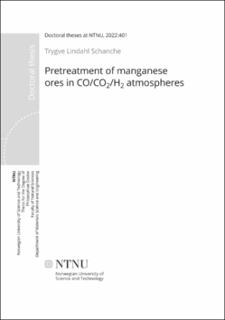| dc.description.abstract | During industrial production of manganese ferroalloys, the manganese raw materials are prereduced in the low temperature zone of the submerged arc furnace (SAF). The endothermic Boudouard reaction (CO2 + C = 2CO) consumes most of the CO2 produced above 800 °C and will consume CO2 from the prereduction reactions occurring above this temperature, resulting in excess consumption of energy and carbon. The energy and carbon consumption are affected by additional factors such as ore quality, flux addition and operational conditions, however calculations and industrial measurements indicate that reduction in the range of 300 kWh and 70 kg C per ton alloy produced is theoretically possible by improved prereduction. Pretreatment of the ore may thus be used to reduce this excess carbon and energy consumption.
In this work, the prereduction behavior of two commercial manganese ores is investigated in conditions simulating a pretreatment unit. In the pretreatment unit, moisture and bound water is evaporated and the raw materials are prereduced prior to their addition to the furnace. This will improve the overall prereduction thus reducing the excess carbon and energy consumption. To avoid the Boudouard reaction in the pretreatment unit, prereduction was investigated at temperatures below 800 °C. Prereduction in different CO/CO2 mixtures were studied to simulate the use of furnace off-gas. In addition, reduction in CO/CO2/H2 gas mixtures, with similar pO2 to the utilized CO/CO2 mixtures, was studied to evaluate the effect of H2.
The investigated ores represent different types of raw materials. Nchwaning ore is a dense ore, mainly consisting of Mn2O3 type oxides in addition to a small amount of carbonates, while Comilog ore is a porous ore that consist of MnO2 type oxides and has a significant content of bound water. During reduction of Nchwaning ore, the Mn2O3 oxides were reduced to MnO without formation of Mn3O4. Iron oxides were reduced to FeO which was stabilized in solid solution with MnO. Carbonates other than calcite decomposed. The reduction of Comilog ore is characterized by a rapid initial decomposition of bound H2O in parallel with MnO2 reduction. MnO2 is reduced directly to MnO above 370 °C, while some accumulation of Mn3O4 occurs below this temperature due to the relatively slower reduction of Mn3O4 to MnO compared to MnO2 to Mn3O4. Both the different porosities and mineral composition of the ores cause differences in their reactivity. The reduction of Comilog ore is initiated and completed at lower temperatures compared to Nchwaning ore, hence, most of the experiments on Comilog ore were conducted in the temperature range 365-455 °C, whereas the less reactive Nchwaning ore was reduced between 605-790 °C.
The reduction rate increased with increasing temperature and decreasing pO2, as expected. In hydrogen containing gas mixtures, the reduction rate was higher compared to CO/CO2 gas mixtures at constant pO2, and it is suggested that this is caused by the improved diffusion properties of hydrogen. Modeling revealed an increased reduction rate by a factor 1.8-3.4 for Nchwaning and 1.7-1.9 for Comilog ore by using a hydrogen containing gas mixture at constant partial pressure. The dependency on reducing gas content was higher for CO/CO2 gas mixtures compared to hydrogen containing gas mixture i.e., the reduction rate is more severely retarded by depletion of reducing gas when hydrogen is not present.
The improved reduction rate using hydrogen in the gas mixture makes it possible to pretreat the ores at lower temperatures when hydrogen is utilized, or to achieve a higher degree of prereduction at the same temperature compared to the use of CO/CO2 gas mixtures alone.
With the addition of H2 to the gas mixture, the water gas shift reaction (CO +H2O = CO2 + H2) is expected. From the off-gas at the end of the experiments, it was seen that the reaction occurred above 410 °C, and approached equilibrium with increasing temperature towards 790 °C. The addition of H2 was also seen to facilitate carbon deposition between 455-605 °C.
It was found that the Comilog ore samples reduced at 455 °C and below, oxidized upon exposure to air at room temperature, which was caused by oxidation of MnO to Mn3O4. The degree of reoxidation at constant temperature was lower in the samples reduced with hydrogen in the gas mixture, which may be due to that the formed MnO is more evenly distributed throughout the particles and thus less accessible to oxygen compared to the samples reduced in CO/CO2 gas mixtures. Reoxidation of Nchwaning ore was not observed. Nchwaning ore was reduced at higher temperatures compared to Comilog ore, and the monoxide (MnO) -phase has a higher content of FeO. Both factors are known to stabilize MnO against reoxidation.
After each experiment, the ore was sieved and the ore on each sieve was weighed to determine the decrepitation of the ores. The decrepitation of Nchwaning ore was found to be a function of degree of reduction while the decrepitation of Comilog ore was also dependent on reduction temperature. Comilog ore reduced at low temperatures decrepitated more compared to when higher temperatures were used despite a higher degree of reduction for the latter case.
Prereducing manganese ores to MnO-FeO is feasible at low temperatures (515-790 °C). The remaining contribution to the excess carbon and energy consumption industrially is the reduction of FeO to metallic iron and decomposition of calcite. It was seen that improving the prereduction has a significant impact on the composition and amount of off-gas from the furnace. i.e., reducing carbon and energy consumption simultaneously reduces the reducing gas content and the amount of off-gas from the SAF. | en_US |
